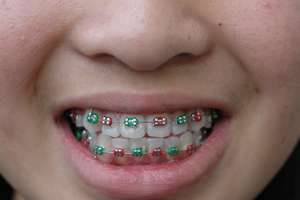Buck teeth: Correct them once in early adolescence

Children with prominent front teeth, colloquially known as buck teeth, often require orthodontic work to straighten their teeth and improve both their bite and appearance. This can be done in one stage during early adolescence (age 10 to 16) or two stages with the first stage between age 7 and 11 and the second in early adolescence. A new Cochrane review finds few benefits to the two-stage correction.
Upper front teeth that stick out are more likely to be broken or knocked out in an accident. In addition, their appearance can lead to a child being made fun of or being bullied. But orthodontists, parents, and children are faced with deciding whether to treat in two stages, early and late, or in just one later stage.
The research team analyzed data from 17 randomized controlled trials of children treated for Class II malocclusion, which is one cause of prominent front teeth. The trials included 721 children.
They concluded that providing treatment early slightly reduced the risk of a child damaging their front teeth if they had an accident while playing or participating in sports, but offered few other benefits. "There was no other benefit for having treatment early, age 8, as opposed to having treatment during adolescent age," according to Kevin O'Brien, professor of orthodontics at the University of Manchester in England.
"The results of this review will provide information to allow the orthodontist to explain fully the potential risks of not having treatment when the child is 8 years old," O'Brien stated. This can help orthodontists, parents and their children make an informed decision, he said.
The study also looked at evaluations of several types of orthodontic braces and appliances, including fixed and removable devices and head-braces. One type, the Twin-Block, was shown to be more effective in reducing the protrusion of the upper front teeth at an early age.
There is no official standard of care when it comes to treating prominent front teeth, David L. Turpin, D.D.S., Moore/Riedel Professor in the department of orthodontics at the University of Washington School of Dentistry in Seattle. "Teeth come in all types of bite and jaw relationships and children come in all shapes and sizes," he said. "Orthodontists should know all the different ramifications and should be good at treating problems in differing ways to meet the child's needs."
"In general, the earlier that treatment starts the longer it lasts, which in turn increases the cost," Turpin said.
More information: Thiruvenkatachari B, Harrison JE, Worthington HV, O'Brien KD. "Orthodontic treatment for prominent upper front teeth (Class II malocclusion) in children." (Review). 2013, Cochrane Library. Issue 11.


















